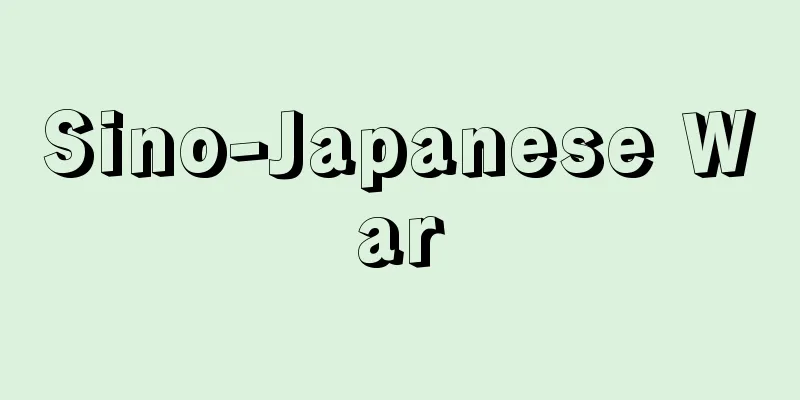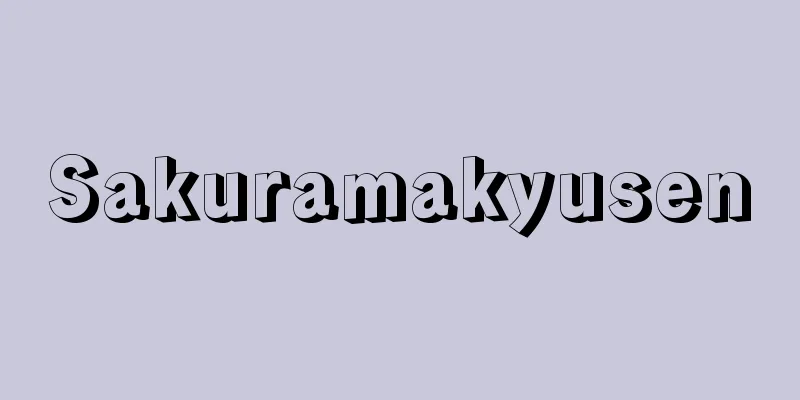Sino-Japanese War

|
A war between Japan and the Qing Dynasty (China) that took place from the summer of 1894 (Meiji 27) to the spring of the following year, mainly over the control of Korea. In China, it is called the Sino-Japanese War of 1894, after the Chinese zodiac sign of the year. [Akira Nakatsuka] Prewar relations between Japan and Korea/QingImmediately after the establishment of the Meiji government, Japan's policy of aggression towards Korea became an important foreign policy of the government, resulting in the Ganghwa Island incident in 1875 (Meiji 8), and forcing Korea to sign the unequal Japan-Korea Treaty of Amity the following year in 1876. However, the Korean people long remembered the national suffering caused by Toyotomi Hideyoshi's invasion of Korea, and many Confucian scholars were wary of invasions by Western capitalist countries, and advocated the theory of protecting the righteous and expelling the evil, arguing that Japan was also a "foreign traitor." After the Treaty of Amity was concluded, as the Japanese, using their privileges as a backdrop, intensified their oppression of Korea, anti-Japanese sentiment in Korea surfaced at every opportunity. In 1882, a riot broke out in Seoul (the Jingo Rebellion) by the family of Queen Min, who was the ruling power at the time, as well as soldiers and urban poor who opposed Japan. The Japanese government subsequently concluded the Treaty of Jemulpo (Jemulpo is a place name in Incheon) and stationed troops in Seoul. Furthermore, in 1884, Japan intervened in a coup d'état (the Gapsin Coup) launched by young aristocrats who sought Korea's independent modernization, thereby expanding Japan's influence. On the other hand, the Korean dynasty government held a strong vassal mentality, and after the Jingo Rebellion, it became increasingly dependent on the Qing Dynasty, which had been sending troops to Korea and expanding its influence. In 1885, the Treaty of Tianjin was signed between Japan and China, which led to the withdrawal of both Japanese and Chinese troops from Korea and a promise to notify each other of future military deployments. However, China gradually strengthened its influence in Korea, and by the 1890s, Japan's trade with Korea had also declined in comparison. Before the First Sino-Japanese War, Japan's trade with Korea was relatively light, accounting for 1.5% of total exports and 2.3% of total imports (1893). However, Japan's trade with Korea had a serious impact on Korean society, and Japan's import of large quantities of Korean rice in particular was one of the factors that led to the intensification of the exploitation of Korean farmers, and was also the background to the Donghak Peasant War. The outflow of gold bullion to Japan also dealt a major blow to the establishment of a modern currency system in Korea. [Akira Nakatsuka] War diplomacyIn 1890 (Meiji 23), the Imperial Diet was held in Japan, but the Meiji bureaucratic government, which was not based on a parliament or political parties, frequently clashed with the parliament and faced political crises. In order to avoid this political crisis, the Japanese government was forced to consider, around March 1894, whether to succeed in revising the treaty with Great Britain, which was being promoted at the time, to start a foreign war to divert the attention of the people, or to suspend the constitution through a coup d'état. Therefore, when the Donghak Peasant Rebellion broke out in Korea at that time, Japan took notice, and when the Korean government requested the Qing Dynasty to send troops, Japan also sent troops, hoping to use this as an opportunity to start a war between Japan and China. On May 31, the Sixth Diet passed a petition to impeach the government, and on June 2, the Diet was dissolved and the decision was made to send troops to Korea. While the Qing army landed in the Asan area near the outbreak of the Peasant Rebellion, by mid-June, about 4,000 Japanese troops were stationed between Seoul and Incheon. However, the Korean peasant army was disbanded, and contrary to Japan's expectations, the Qing army also avoided clashes with the Japanese army, so there was no pretext for starting a war. The Japanese government then proposed that both Japan and China reform Korea's domestic affairs, and when China rejected this, they insisted on Japan's independent reforms, trying to subordinate Korea while at the same time provoking China into starting a war. In the ongoing negotiations with Great Britain to revise the treaty, Japan tried to gain Britain's support in preparation for the outbreak of war with China, making repeated concessions, and finally succeeded in signing a revised treaty with Great Britain on July 16 (the Anglo-Japanese Treaty of Commerce and Navigation). Immediately after that, on the 19th, they began operations aimed at starting a war, and on July 25th, they attacked the Qing fleet off the coast of Houtou, southwest of Incheon, and thus began the Sino-Japanese War. [Akira Nakatsuka] The course of the warOn land, the Japanese also defeated the Chinese army at Seonghwan, northeast of Asan, on July 29th, and war was declared on August 1st. During the war, the Japanese army, which had been preparing for war with China for the past 10 years, successively defeated the Beiyang Army and Navy of China, which had a strong character as a private army under Li Hongzhang, and with the Japanese victory in the Battle of Pyongyang on September 14-15th and the naval battle of the Yellow Sea on the 17th, the fortunes of both Japan and China became clear. In late October, the Japanese First Army crossed the Yalu River, and the Second Army also landed on the Liaodong Peninsula, occupying Port Arthur and Dalian in November. In the following year, 1895, in February, they attacked Weihaiwei on the Shandong Peninsula from land and sea in an attempt to annihilate the Beiyang Fleet, occupying the town, and in March they completely conquered the Liaodong Peninsula and then moved south to occupy Taiwan. Thus, the Sino-Japanese War progressed with victories for the Japanese army, but at the same time, in Korea, ethnic conflict between Japan and the Korean people began to intensify. The peasant army, which had once seemed to be calming down, rose up again in the autumn of 1894, and over the next year clashed and fought with the Japanese army in various places. The peasant army's target was now directed not at Korea's feudal ruling class, but at the Japanese army that was invading Korea, and it took on the characteristics of a popular national liberation struggle, which was linked to the Itsumi Righteous Army of 1895 and the subsequent anti-Japanese Righteous Army struggle. [Akira Nakatsuka] Peace TreatyImmediately after the Battle of Pyongyang and the Yellow Sea, the British started to mediate peace, and the Qing Dynasty sent a peace envoy to Japan in January 1895. However, the Japanese military had not yet succeeded in completely occupying the Liaodong Peninsula or capturing Weihaiwei, and had not yet sent troops to Taiwan, so they did not take these peace efforts seriously. While expanding their military gains, they also finalized a draft of a peace treaty, and finally, with the mediation of the United States, held a peace conference in Shimonoseki in late March 1895. On March 24, a sudden incident occurred in which the Qing Plenipotentiary Li Hongzhang was shot and injured by a Japanese thug. The alarmed Japanese government agreed to a ceasefire on March 30, then signed the peace treaty on April 17, and exchanged instruments of ratification in Chifu, China, on May 8. The main points of the Sino-Japanese Peace Treaty (Treaty of Shimonoseki) were: (1) China would recognize the independence of Korea, (2) the Liaodong Peninsula, Taiwan, and the Penghu Islands would be separated from China and become Japanese territory, (3) China would pay 200 million taels (approximately 300 million yen) in indemnity, and (4) the cities and ports of Shashi, Chongqing, Suzhou, and Hangzhou would be opened to Japan, as well as the trade privileges that Western countries had enjoyed in China. The trade privilege clauses included the privilege of building factories and starting manufacturing industries with foreign capital in open ports, which Britain and other countries had requested from China at the time but had not yet received. It appears that Japan was trying to represent the interests of Britain and other countries through the peace treaty, thereby preventing interference in Japan by countries such as Russia. [Akira Nakatsuka] Historical SignificanceThe Sino-Japanese War was the first full-scale war that modern Japan experienced, and by winning it, Japan established itself as an oppressor not only to Korea but also to China, and opened a major breakthrough in joining the ranks of imperialist nations alongside the Western powers. However, as a result, as can be seen from the so-called Triple Intervention by Russia, Germany, and France that occurred six days after the signing of the Sino-Japanese Peace Treaty, Japan was forced to face conflicts among the imperialist powers and further advanced down the path of militarization. Furthermore, the ethnic conflicts between Japan, Korea, and China deepened day by day, and a trend of despising Asia began to spread among the Japanese people. [Akira Nakatsuka] "Kenkenroku" by Mutsu Munemitsu (Iwanami Bunko)" ▽ "Study of the Sino-Japanese War" by Nakatsuka Akira (1968, Aoki Shoten)" ▽ "The Sino-Japanese War" by Fujimura Michio (Iwanami Shinsho) [References] | | | [Chronology] |A full-scale battle in the First Sino-Japanese War took place on July 29, 1894 (Meiji 27). The Japanese army defeated the Chinese army at Seonghwan, northeast of Asan, and declared war on August 1. Utagawa Kunitora's painting "A Picture of Japan's Great Victory in the Battle of Asan, Korea " (National Diet Library ) Battle of Seonghwan (Battle of Asan) ©Shogakukan "> Map of the Sino-Japanese War Source: Shogakukan Encyclopedia Nipponica About Encyclopedia Nipponica Information | Legend |
|
1894年(明治27)の夏から翌年春にかけて、主として朝鮮の支配をめぐって戦われた日本と清国(中国)との戦争。中国では、1894年の干支(えと)から、甲午(こうご)中日戦争という。 [中塚 明] 戦争前の日本と朝鮮・清国との関係日本では明治政府成立の直後から、朝鮮侵略政策が政府の重要な対外政策となり、1875年(明治8)には江華島(こうかとう)事件を引き起こし、翌1876年には朝鮮側に一方的に不平等な日朝修好条規を結ばせた。しかし、朝鮮では豊臣(とよとみ)秀吉の朝鮮侵略によって受けた民族的苦痛は長く記憶され、そのうえ欧米の資本主義国の侵入を警戒し、日本も同じく「洋賊」であるとする衛正斥邪(えいせいせきじゃ)論を主張する儒学者も多かった。日朝修好条規締結後、特権を背景に日本人の朝鮮への圧迫が強まるにつれ、朝鮮の反日の気運は事あるごとに表面化した。1882年には、時の執権勢力であった王妃=閔妃(びんひ)一族および日本に反対する兵士と都市貧民の暴動がソウルに起こった(壬午(じんご)軍乱)が、日本政府はこのあと済物浦(さいもっぽ)条約(済物浦は仁川(じんせん)の中の地名)を結び、ソウルに軍隊を駐屯させた。さらに1884年には、朝鮮の自主的近代化を目ざす開化派青年貴族たちが起こしたクーデター(甲申(こうしん)政変)に介入し、日本の勢力拡大を図った。一方、朝鮮の王朝政府では事大主義的な考えが強く、壬午軍乱後、朝鮮に軍隊を送り勢力を伸ばしてきた清国に依存する傾向が強まった。1885年、日清間に天津(てんしん)条約が結ばれ、朝鮮から日清両軍は撤退し、今後の出兵に際しては相互に通知することが約束されたが、清国は徐々に朝鮮への影響力を強め、1890年代に入ると、貿易でも日本は相対的に後退するようになった。日清戦争前の日本の対朝鮮貿易は、全輸出総額中の1.5%、全輸入総額中の2.3%(1893)で、その比重は比較的軽かった。しかし、日本の対朝鮮貿易が朝鮮社会にもたらした影響は深刻で、とりわけ日本が朝鮮米を大量に輸入したことは、朝鮮で農民収奪強化の一因となり、甲午農民戦争(東学党の乱)を引き起こす背景ともなった。また金地金(きんじがね)の日本への流出も、朝鮮の近代的幣制樹立に大きな打撃を与える結果となった。 [中塚 明] 開戦外交1890年(明治23)日本では帝国議会が開かれたが、議会と政党に基礎を置かない明治の官僚政府は、これ以後しばしば議会と衝突、政治的危機にみまわれた。その政治的危機を回避するため、1894年3月ごろには、当時進められていたイギリスとの条約改正に成功するか、対外戦争を引き起こして国民の関心を外にそらせるか、またはクーデターによって憲法を停止するか、とまで考えざるをえない状況に、日本政府は立ち至っていた。したがって、ちょうどそのころ朝鮮に甲午農民戦争が起こると、これに注目し、朝鮮政府が清国に出兵を請うと、日本も出兵し、これを機会に日清間の戦争を始めようとした。5月31日、第六議会で政府弾劾の上奏案が可決されると、6月2日には議会を解散すると同時に、朝鮮への出兵を決定し、清軍が農民戦争発生地近くの牙山(がざん)方面に上陸したのに対し、日本軍は6月中旬までに約4000人がソウル、仁川の間に布陣した。しかし、朝鮮の農民軍は解散し、清軍もまた日本の予期に反して日本軍との衝突を避け、そのため開戦の口実がみつからなかった。そこで日本政府は、日清両国による朝鮮の内政改革を提案、それを清国が拒否すると日本による単独改革を主張、朝鮮の従属化を図ると同時に、清国を挑発して開戦に持ち込もうとした。また、進行中のイギリスとの条約改正交渉では、日清開戦に備えてイギリスの支持を得ようとし、日本は譲歩を重ね、7月16日ついにイギリスとの条約改正の調印に成功した(日英通商航海条約)。その直後の19日から開戦を目標にした作戦行動を開始し、7月25日、仁川南西方、豊島(ほうとう)沖合いで清国艦隊を攻撃、ここに日清戦争が始まった。 [中塚 明] 戦争の経過陸上でも、7月29日、牙山の北東、成歓(せいかん)で清国軍を打ち破り、宣戦布告は8月1日行われた。戦争では、10年来、清国との戦争を目ざして準備してきた日本軍が、李鴻章(りこうしょう)の私兵的性格の強い清国の北洋陸海軍を相次いで破り、9月14~15日の平壌の戦い、17日の黄海(こうかい)の海戦で日本軍が勝つと、日清両国の明暗がはっきりしてきた。日本軍は10月下旬、第一軍が鴨緑江(おうりょくこう)を渡り、第二軍も遼東(りょうとう)半島に上陸、11月中に旅順(りょじゅん)、大連(だいれん)を占領。翌1895年に入ると、2月には北洋艦隊を殲滅(せんめつ)するため、陸海から山東(さんとう)半島の威海衛(いかいえい)を攻め、ここを占領、3月には遼東半島を完全に制圧し、さらに南方の台湾占領に向かった。このように日清戦争は日本軍の勝利のうちに進んだが、同時に朝鮮では、日本と朝鮮人民との民族的対立がかえって激化し始めた。いったん鎮静に向かったかにみえた農民軍が、1894年秋、再蜂起(ほうき)し、翌年にかけて各地で日本軍と衝突、交戦した。農民軍の矛先は、朝鮮の封建支配階級から、朝鮮を侵略する日本軍に向けられ、1895年の乙未(いつみ)義兵、さらにその後の反日義兵闘争に連なる大衆的な民族解放闘争の色合いを強めた。 [中塚 明] 講和条約平壌・黄海の戦闘の直後から、イギリスの講和斡旋(あっせん)の動きがみえ、清国も1895年1月、講和使節を日本に送ってきた。しかし、当時日本軍はまだ遼東半島の完全占領や威海衛の攻略に成功しておらず、台湾へは出兵もしていなかったから、この講和の動きに取り合わなかった。そして戦果を広げる一方、講和条約の草案を具体化し、やっとアメリカの仲介で、1895年3月下旬から下関(しものせき)で講和会議を開いた。3月24日、清国全権李鴻章が日本人暴漢に狙撃(そげき)され負傷する突発事件が起こり、周章した日本政府は3月30日休戦に応じ、ついで4月17日に講和条約に調印、5月8日、中国の芝罘(チーフー)で批准書の交換を行った。日清講和条約(下関条約)の要点は、〔1〕清国が朝鮮の独立を承認すること、〔2〕遼東半島、台湾、澎湖(ほうこ)島を清国から分割、日本の領土とすること、〔3〕清国は賠償金2億両(テール)(約3億円)を支払うこと、〔4〕沙市(さし)、重慶(じゅうけい)、蘇州(そしゅう)、杭州(こうしゅう)を開市・開港するほか、欧米諸国が清国にもっている通商上の特権を日本にも認めること、などの4点である。通商特権の条項中には、当時イギリスなどが清国に要求して、まだ獲得していなかった開港場で外国資本により工場を建て製造業をおこす特権なども含まれており、講和条約を通じてイギリスなどの利益を日本が代弁し、そのことによって、ロシアなどの日本への干渉を未然に防止しようと図った節がある。 [中塚 明] 歴史的意義日清戦争は、近代日本が初めて体験した本格的な戦争であったが、これに勝利することによって、日本は朝鮮のみならず中国に対しても圧迫国の地位にたち、欧米列強と並んで帝国主義国家の仲間入りするうえに大きな突破口を開いた。しかし、この結果、日清講和条約調印後6日目に、ロシア、ドイツ、フランスによるいわゆる三国干渉が起こったことからもわかるように、日本は帝国主義列強間の対立にいやおうなしに直面し、軍国主義化の道をますます進むことになった。また、日本と朝鮮、中国との民族的矛盾も日を追って深まり、国民思想のなかにアジアを蔑視(べっし)する風潮が広まるようになった。 [中塚 明] 『陸奥宗光著『蹇蹇録』(岩波文庫)』▽『中塚明著『日清戦争の研究』(1968・青木書店)』▽『藤村道生著『日清戦争』(岩波新書)』 [参照項目] | | | [年表] |1894年(明治27)7月29日に起こった、日清戦争における本格的戦闘。日本軍は牙山の北東、成歓で清国軍を打ち破り、8月1日に宣戦布告した。歌川国虎画『朝鮮国牙山開戦日本大勝利之図』国立国会図書館所蔵"> 成歓の戦い(牙山の戦い) ©Shogakukan"> 日清戦争関係図 出典 小学館 日本大百科全書(ニッポニカ)日本大百科全書(ニッポニカ)について 情報 | 凡例 |
<<: Daily Reflections - Nisseiroku
>>: Nisshin Flour Milling Co., Ltd.
Recommend
Simson, R.
...Let D, E, and F be the feet of the perpendicul...
Mount Emei (Japan) - Gabisan
…After World War II, the area temporarily decline...
Okinawa Mekura - Okinawa Mekura
...Its English name is hagfish (a fish that resem...
Otomo District - Otomo District
...According to the Engishiki, the province had 1...
sauterelle
…This is one of the few cases in Europe and Ameri...
Pressure microphone
A microphone that has an electrical output proport...
Simpson, George Gaylord
Born June 16, 1902 in Chicago, Illinois Died: Octo...
Accounting office documents - Kanjoshomonjo
...Some of the Hyōjōshō documents were transferre...
Sanno Miraculous Tale - Sanno Miraculous Tale
Picture scrolls. There are two types: one that des...
Giscar d'Estaing, V. (English spelling) GiscardEstaingV
…Fifth Republic [Haruyasu Kato]. . … *Some of the...
Ernest Solvay
Belgian industrial chemist. Born in Labèque near ...
Tipping thermometer - Tentō ondōkei
A special thermometer used to measure the temperat...
Silver plate - Ginban
...a method of increasing the sensitivity of phot...
Seahorse (Dragon's Child) - Seahorse
A fish of the Syngnathidae family. Locally known a...
Counter-revolution
It refers to movements or forces opposed to the r...









